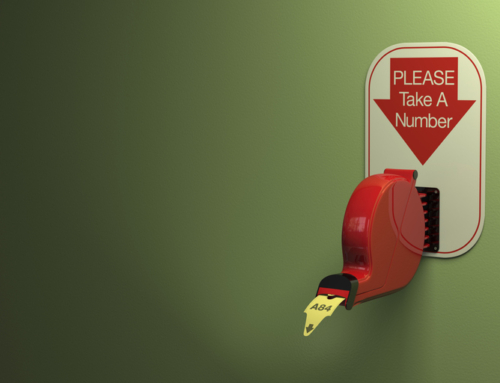According to researchers at Wharton and Goethe University: “Referred customers are more loyal and have a 16% higher lifetime value.”
Research from Nielsen reports that people are four times more likely to buy when referred by a friend.
A robust referral program should be included in every marketer’s tactical arsenal. Here are some thoughts to help add it to yours.
The first step is to provide world-class service and a product that people want. In short, you need to stand out from the crowd … make people want to talk about you without even asking.
Then ASK!
Research from Texas Tech uncovered that 83% of satisfied customers are willing to refer to a company, but only 29% do. “The ask,” is a cultural shift. Once your team sees positive results, it will become easier for them to ask for referrals. But, today, they see themselves as simply doing their jobs … not positively affecting people’s lives. And why should they ask for a referral for just doing their job?
The Psychology of Referrals
MarketMatch conducted several brief and non-scientific interviews on the psychology of referrals. In almost all cases, a referral was not provided because of a reward incentive, but rather because a referrer is being helpful. This notion was also supported by comments from clients, “The $20 referral bonus was not the driver, but a ‘nice extra.’”
A referral is a personal endorsement – where a customer shares a positive experience with another. We must capitalize on the personal experiences when they happen. Great service gets rewarded with referrals. Wrapping the entire program around an internal “Service Promise” program gives it sustainability and high internal visibility. It also ties referrals to expertise, quality service and satisfaction. Lastly, you should consider “branding” the process with a memorable and powerful name and position statement.
I believe that referrals are an emotional decision and that a person refers a “person” more than a “place.” You have thousands of personal interactions with customers every year … and thousands of opportunities to EARN a referral. Rather than a “would you like fries with that” approach that commoditizes the referral “ask,” we recommend a personal referral strategy. This approach will also make the referral a highly-valued process from “one person of trust” to another and tie the emotion of satisfaction and expertise into the “ask.”
The Immediate Ask
If it’s true that people refer people, then your people need to ask as soon as they do something awesome. I believe that every time a customer opens a new account with you, they are “renewing their vows.” You should be asking for referrals at every account opening … Ideally at point of sale or with hand written notes that are mailed within 24-hours.
Keep in mind that this isn’t just a sales representative thing. Anyone can generate referrals … even your collections department. Have they ever helped someone by extending or postponing payments? That’s a great time to ask for a referral! When your call center works their magic to “save the day,” ask for a referral. When a teller helps someone leave the branch happier than when they walked in, ask!
Automate It
The key to successful referral program is ease. If it’s not easy for the staff and for the customer, no amount of asking or incentive in the world will drive opportunity.
I recommend that you create a dedicated referral page on your website with a lead generation form that emails to an accountable team member for one-on-one follow-up.
If you have online application capabilities, that should, of course, be front and center. But again, you are more likely to have success when there is personal contact, rather than sitting back waiting for the prospect to act.
Control the Relationship
Most referral programs simply hand off a message or incentive offer to an existing customer, then sit back and wait.
I recommend that you keep control of the process as much as possible. Yes, you can keep the referrals that are handed from one person to another … where the new customer simply walks in to open an account. But proactive action beats “hopes and prayers.” Generate leads, where prospects complete an easy online form, checking off what product they are most interested in. Have the leads email to your team, then let your hunters hunt.
The Tools
Once your dedicated referral page is in place, everything should drive prospective customers either to a branch or to the page.
You need to provide your existing customer with a tool that they can easily share with their friends and family. A business card-sized piece detailing any incentives and the URL to your referral page. Or an email that they can forward with a link to your referral page.
Provide a sample message that your team can use as a base and customize to their personal style:
“I hope that I’ve taken care of all your needs today. XYZ Bank/Credit Union strives to make sure that each of our customers are 100% satisfied. If you know of anyone who I might be able to help, I would appreciate it if you would refer me to them by sending them this easy link…”
Beyond the Branch
Once your team has taken care of the day-to-day relationship “asks,” your marketing department can lend support:
- Send email follow-ups 2-3 weeks after each new account opening with a link to the referral page.
- Send occasional “shotgun” emails to all customers asking them to forward the email with the web link to friends and family.
- Post the referral link on social media, possibly with a testimonial from an existing customer to remind the world how awesome you are.
Incentives
Sometimes you need to do more than just ask.
Is it better to give or to receive? Or, do you reward both the referrer and referee? Do you need an incentive at all? Do incentives “cheapen” the ask?
A 2013 study, “Electronic word of mouth: The effects of incentives on e‐referrals by senders and receivers,” found that, “Offering higher incentives to senders and receivers led to an increase in referral invitations sent, new member sign‐ups and new buyers.”
In other words, if it fits your brand, culture and budget, incentives will improve results.
When you’re planning incentives, consider:
- Do you incent for the lead or the actual sale? If you have a strong sales team, the leads may be more lucrative than waiting for the prospective customer to come in.
- Should you provide the same “bounty” for everyone or tier incentives based on the value of the new customer? Are checking accounts worth more than auto loans?
- Can you gamify incentives? Each referral is an entry into a quarterly contest, for example.
Tracking
You should have tracking in mind as you plan your communication tools.
- Track where your referrals are coming from: printed cards, online applications, lead generation forms.
- Who are your referrals coming from: New customers or older customers with new accounts? Referrals after significant experiences? Social media?
- What are the common points of entry for new customers: Checking? Auto loan?
- How do referral relationships compare to other customers: Are you seeing the 16% bump that Wharton and Goethe University predicts?
When you have a strong referral program, your sales and marketing team becomes thousands strong. And your ROI is based on actionable leads and sales. It’s time to put some Refer Madness into your marketing plan.



